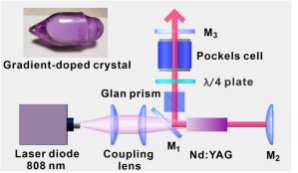High-peak-power electro-optically Q-switched laser with a gradient-doped Nd:YAG crystal: Part 2
[Cited from: OPTICS LETTERS, Authors: Meng-En Wei, etc.]
A comparable laser performance was demonstrated by using a gradient-doped Nd:YAG crystal with a continuously varying dopant concentration profile. Pumping with a multi-mode high-power laser diode at 803 nm, a maximum output power amounted to 187 W at an absorbed pump power of 350 W. The corresponding optical conversion efficiency reached up to 53%. The promising thermo-optical features and previous laser results motivated us to further explore the potential of this gradient-doped Nd:YAG crystal operating in the Q-switched regime for nanosecond pulse generation at a high repetition rate and near-diffraction-limited beam profile. In the present work, a high-quality composite Nd:YAG crystal (www.wisoptic.com) was grown by the modified Czochralski method with a continuously varying Nd3+ dopant concentration from 0.39% to 0.80%. The anti-reflection coated Nd:YAG rod had a dimension of 3 mm in diameter and 40 mm in length. The barrel surface of the Nd:YAG rod was polished to optical quality.
Nowadays, the electro-optically (EO) Q-switched laser is a common way to achieve sub-10 ns pulses in the DPSSL with a high repetition rate at ~1 µm. The scaling of average power and pulse energy is still a challenge in the end-pumped configuration with respect to reducing the thermal load to acceptable limits and maintaining the thermal lens and aberrations as low as possible to generate a diffraction-limited laser beam from the resonator. In this work, we focus on the study of the gradient- doped Nd:YAG crystal with a continuously varying dopant concentration profile as a gain medium in combination with an EO Q-switcher for pulsed operation. A near-diffraction-limited laser beam with a maximum average output power of 6.9 W and a pulse repetition rate of 2 kHz was achieved at 1064 nm. The shortest pulse duration is down to 5.9 ns, which corresponds to a maximum peak power of ~585 kW. Additionally, a comparison of laser performances was investigated with uniformly dopant crystals. Our results indicate a significant improvement in both average output power and slope efficiency.
The experimental configuration of the EO Q-switched laser is shown in Fig. 1. An 808 nm fiber-coupled laser diode with a 400 µm core diameter and 0.22 NA was used as the pump source. The pump light was focused to a diameter of 1000 µm in the center of the Nd:YAG crystal through the coupling system. An L-shaped dynamically stable resonator was employed to evaluate the Q-switched laser performance with a cavity length of 160 mm. M1 was a 45° dichroic mirror exhibiting high reflectivity at 1064 nm and high transmission at 808 nm. The radius of curvature of M2 was set to R = +160 mm to provide thermal lens compensation, thus shifting the resonator’s stability range to a high pump level. M3 was a flat output coupler (OC) with four OCs with transmissions of TOC = 40%, 45%, 50%, and 55% at 1064 nm. A tilted Glan–Taylor prism and a quarter- wave plate was implemented in the resonator for compensating thermal-induced depolarization losses. The potassium dideuterium phosphate Pockels cell was utilized as a Q-switch. Three uniformly dopant Nd:YAG crystals with different doping concentrations of 0.40 at.%, 0.60 at.%, and 0.80 at.% were used for comparison. A gradient-doped Nd:YAG crystal with a concentration of 0.39–0.80 at.% served as the gain medium, and the incident end involved two pumping directions for 0.39 at.% and 0.80 at.%. The repetition rate of the pump laser was set to 2 kHz with a pulse duration of 230 µs.
Fig. 1. Experimental setup of the EO Q-switched Nd:YAG laser
Post time: Feb-24-2022

